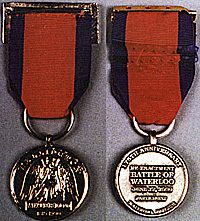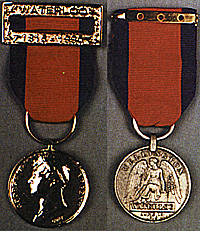The medals shown are imitation medals provided to re-enactors.

The medal struck for the Victory of Waterloo was the first of military campaign medals as we know them today, being awarded by the British govenament to officers and other ranks alike. It was conferred on all present at one or more of the three battles on the 16th, 17th, and 18th June, 1815. It was issued soon after the action in 1816, and as a result, more frequently worn. In addition to receiving the medal, every soldier present was credited with two years extra service. For the first time, each medal bore the recipient's name, making it possible for the service record and biographical data to be checked.
Writing to the Duke of York, Commander in Chief of the British Army, in a letter dated 28 June, 1815, the Duke of Waterloo wrote, "I would likewise beg leave to suggest to your Royal Highness the expediency of giving to the non-commissioned officers and soldiers engaged in the Battle of Waterloo a medal. I am convinced it would have the best effect in the army; and if that battle should settle our concerns, they will well deserve it."
In another letter from the Duke of Wellington to Earl Bathurst, Secretary of State for the War Department, on the 17th of September, he stated his recommendation that, "we should all have the same medal, hung to the same ribbon as that now used with the medals."
 The Waterloo Medal has on the obverse the laureated head of the Prince Regent, inscribed GEORGE P REGENT. On the reverse is Victory seated on a pedestal, holding a palm in
the right hand, and an olive branch in the left. Above the figure of Victory is the name WELLINGTON, and under it is the word WATERLOO, with the date of the Battle, June 18, 1815. This figure originated on a Greek coin presently preserved in the British Museum.
The Waterloo Medal has on the obverse the laureated head of the Prince Regent, inscribed GEORGE P REGENT. On the reverse is Victory seated on a pedestal, holding a palm in
the right hand, and an olive branch in the left. Above the figure of Victory is the name WELLINGTON, and under it is the word WATERLOO, with the date of the Battle, June 18, 1815. This figure originated on a Greek coin presently preserved in the British Museum.
The name, rank, and regiment of the officer or soldier were engraved around the edge of the Medal, which was suspended from the button-hole of the uniform by the ribbon authorized for the military medals, crimson with blue edges.
It was noted by a visitor to the Duke of Wellington's residence, that the Duke's own medal, engraved "ARTHUR, DUKE OF WELLINGTON," was very worn by use, and had in fact been mended by the Duke himself.
In the London Gazette, 23 April,1816, the following official notification was published:
"Memorandum:
"Horse Guards, March 10th,
1816,
"The Prince Regent has been graciously pleased, in the name and on the behalf of His Majesty, to command, that in commemoration of the brilliant and decisive Victory of Waterloo, a medal should be conferred on every officer, non-commissioned officer, and soldier of the British Army, present upon that memorable occasion.
"His Royal Highness has further been pleased to command that the ribbon issued with the medal, shall never be worn but with the medal suspended to it.
"By command of his Royal Highness, the Prince Regent;
"Frederick, Commander-in-Chief.
"H.Torrens, Major-General and Military Secretary."
Close scrutiny of the famous painting, "The Waterloo Heroes Assembled at Apsley House," by J.P.Knight, shows that the medal was not worn in any consistent position other than high on the left shoulder, and just below the collar being the preferred position. Where these extensively decorated officers placed their various orders and medals seems to be a matter of individual choice.
Distinctions
The distinction for Waterloo became even more valuable because there was only one ribbon and one medal for all ranks of the army, from the Commander of the Forces to the youngest drummer.
Medals from those regiments which suffered great casualties are nowadays more prized by collectors than those for example from General Colville's Reserve Division which was stationed ten miles to the west against possible flanking moves and therefore took no active part in the Battle. Sir Charles Colville's regiments forming this brigade, while granted the medal, do not bear "Waterloo" on their colours.
The Prince Regent also ordered that medals should be given to the Brunswickers who survived the actions at Quatre Bras and Waterloo. This medal was made of bronze from captured guns. Obverse is the bust of Duke Frederick William of Brunswick who fell at Quatre Bras with, "Frederick William Herzog." Reverse, is the date 1815, within a wreath of oak, and the legend, "Braunschweig Seinen Kriegem-Quatre Bras und Waterloo," the ribbon yellow with a light blue border.
The Duke's own medal was
very worn by use,
and had in fact been
mended by
the Duke himself.
The Hanoverian troops present at Waterloo received a silver medal; obverse, the laureated head of the Prince Regent, with the legend, "George, Prinz Regent, 1815." Reverse: "Waterloo, June 18th." Above there is a military trophy, below, laurel branches and the legend, "Hannoversches Tapferkeit." The ribbon is red with a blue border.
To the soldiers of the Duchy of Nassau, a small silver medal was awarded with dark blue ribbon and a yellow edge.
Had the Prince Regent had his way originally, there would have been two Waterloo medals. He had requested a Waterloo medal to be designed by Pistrucci for presentation to each of the Allied Monarchs and the two field commanders, the Duke of Wellington and Blücher. Pistrucci began work on this medal in 1819 and did not complete engraving the dies until 1849, by which time all the intended recipients except the Iron Duke were dead. The project was therefore abandoned. The dies were never hardened and no medals were ever struck This would have been a huge medal (5.3 inches in diameter), and was an example of the love of ornamental symbolism which characterised this particular sculptor's work in the mid 19th century.
In awarding the Waterloo Medal to all participants in the Campaign, and therefore recognizing the contributions from all, the Duke of Wellington and the Duke of York were setting the pattern for more egalitarian ages yet to come, when campaign medals would be awarded as a matter of course to all ranks.
How much do the real medals cost?
Back to Empires, Eagles, & Lions Table of Contents #12
Back to Empires, Eagles, & Lions List of Issues
Back to MagWeb Master Magazine List
© Copyright 1995 by The Emperor's Press
[This article appears in MagWeb (Magazine Web) on the Internet World Wide Web.
Other military history articles and gaming articles are available at http://www.magweb.com]